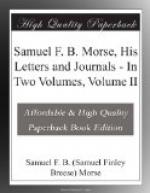Professor Gale’s letter to Henry J. Rogers is worthy of being quoted in full:—
“I have just read a letter from F.O.J. Smith, dated December 11, 1871, addressed to you, and designed to throw discredit on Morse’s invention of the Telegraph, the burden of which seems to be rebuke to the designer of the monument, for elevating Morse to the apex of the monument and claiming for Professor J. Henry, of the Smithsonian Institution, that high distinction.
“The first question of an impartial inquirer is: ’To which of these gentlemen is the honor due?’ To ascertain this we will ask a second question: ’Was the subject of the invention a machine, or was it a new fact in science?’ The answer is: ‘It was a machine.’ The first was Morse’s, the latter was Henry’s. Henry stated that electric currents might be sent through long distances applicable to telegraphic purposes. Morse took the facts as they then existed, invented a machine, harnessed the steed therein, and set the creature to work. There is honor due to Henry for his great discovery of the scientific principle; there is honor also due to Morse for his invention of the ingenious machine which accomplishes the work.
“Men of science regard the discovery of a new fact in science as a higher attainment than the application of it to useful purposes, while the world at large regards the application of the principle or fact in science to the useful arts as of paramount importance. All honor to the discoverer of a new fact in science; equal honor to him who utilizes that fact for the benefit of mankind.
“Has the world forgotten what Robert Fulton did for the navigation of the waters by steamboats? It was he who first applied steam to propel a vessel and navigated the Hudson for the first time with steam and paddle-wheels and vessel in 1807. Do not we honor him as the Father of steamboats? Yet Fulton did not invent steam, nor the steam-engine, nor paddle-wheels, nor the vessel. He merely adapted a steam-engine to a vessel armed with paddle-wheels. The combination was his invention.
“There is another example on record. Cyrus H. McCormick, the Father of the Reaping and Mowing Machine, took out the first successful patent in 1837, and is justly acknowledged the world over as the inventor of this great machine. Although one hundred and forty-six patents were granted in England previous to McCormick’s time, they are but so many unsuccessful efforts to perfect a practical machine. The cutting apparatus, the device to raise and lower the cutters, the levers, the platform, the wheels, the framework, had all been used before McCormick’s time. But McCormick was the first genius able to put these separate devices together in a practical, harmonious operation. The combination was his invention.
“Morse did more. He invented the form of the various parts of his machine as well as their combination; he was the first to put such a machine into practical operation; and for such a purpose who can question his title as the Inventor of the Electric Telegraph?”




